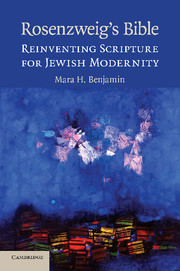Book contents
- Frontmatter
- Contents
- Acknowledgments
- Introduction: The Decline and Renewal of Scripture
- 1 Scripture in The Star of Redemption
- 2 Yehudah Halevi: The Creation of a Scriptural World
- 3 Bible Translation and the Shaping of German Identity
- 4 Toward a New Encounter with the Bible
- Conclusion: Scripture Today – Some Considerations
- Works Cited
- Index
2 - Yehudah Halevi: The Creation of a Scriptural World
Published online by Cambridge University Press: 01 July 2009
- Frontmatter
- Contents
- Acknowledgments
- Introduction: The Decline and Renewal of Scripture
- 1 Scripture in The Star of Redemption
- 2 Yehudah Halevi: The Creation of a Scriptural World
- 3 Bible Translation and the Shaping of German Identity
- 4 Toward a New Encounter with the Bible
- Conclusion: Scripture Today – Some Considerations
- Works Cited
- Index
Summary
In 1923, franz rosenzweig wrote to his friend joseph Prager that he had undertaken a new project:
I have translated a little volume of Yehudah Halevi with an afterword and notes. In the commentary on it I note the places where I was not able to translate literally. Rhyme and meter have been reproduced precisely. The whole thing owes its genesis to Emil Cohn …, [whose book] got me so annoyed that these verses came out.
Emil Cohn, a Berlin-born rabbi, dramaturge, prolific writer of popular works on Jewish history and education, and outspoken Zionist, had recently published a German translation of selections from the dīwān of the twelfth-century Hebrew poet and philosopher Yehudah Halevi. Rosenzweig's intemperate letter refers to the volume that he would publish a few years later called Sixty Hymns and Poems of Yehudah Halevi. Rosenzweig's translation of and commentary on the poems of Yehudah Halevi began as a simple corrective to Cohn, but it grew into something much grander. Rosenzweig's volume constituted nothing less than a proposal for the creation of a distinctively scriptural and liturgical Jewish identity in German language and culture.
Among Rosenzweig's works, Hymns and Poems has suffered from scholarly neglect. Encountering it yields a significant, and notably different, picture of Rosenzweig from the one commonly associated with The Star of Redemption. Hymns and Poems marks the first flowering of Rosenzweig's post-philosophical thought, which culminated in his translation, beginning in 1925, of the Hebrew Bible into German with Martin Buber.
- Type
- Chapter
- Information
- Rosenzweig's BibleReinventing Scripture for Jewish Modernity, pp. 65 - 102Publisher: Cambridge University PressPrint publication year: 2009



